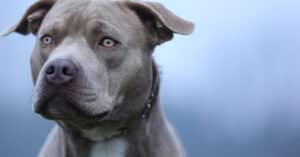Hundreds of years ago, before they were commonly accepted as household companions and members of the family, dogs served many practical roles around the homestead or farm; they were bred for herding, protection, hunting, and other difficult tasks. Many are still used for this purpose today. A good farm dog breed must have several important attributes, including a keen intelligence, athletic body, and immense energy and work ethic. Many are quite loyal and friendly as well. This article will cover some of the most common types of farm dogs and ranch dog breeds from around the world.
#10: Jack Russell Terrier

©iStock.com/alexei_tm
If you’re looking for a capable vermin hunter, then you cannot do much better than the clever and athletic Jack Russell Terrier. These alert, lively dogs were originally bred in 19th century England for fox and badger hunting (hence their amazing talent for digging through dirt), but they also like to pursue and kill rodents as well. Once let loose around the farm, they should keep the property free of disease-carrying vermin. Other alternatives to the Jack Russell include the Rat Terrier, Airedale Terrier, Scottish Terrier, and other small, tenacious dogs.
These dogs can be good pets, but their innate prey drive is extremely high. If you have a terrier as a pet, you will need to find an appropriate outlet for their tenacity and drive. Many kennel clubs have begun doing staged “barn hunts” where the dogs search out a hidden object to simulate hunting. There are also a number of urban rat hunting clubs who get together to allow their fierce little hunters to exercise their skill.
#9: Great Pyrenees
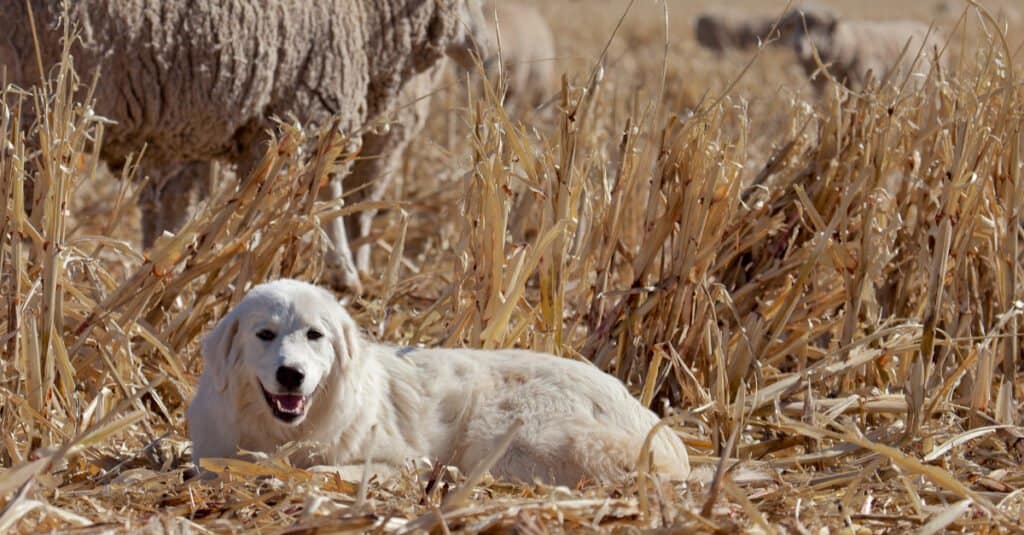
©Ingrid Curry/Shutterstock.com
Originating from the French side of the Pyrenees Mountains near the border of Spain, the Great Pyrenees is a great big livestock guardian that weighs at least 85 pounds and stands up to 32 inches at the shoulders. Swathed in a thick, all-white coat, this breed is well insulated from harsh environmental conditions such as snow and freezing temperatures. It primarily excels at a single task: watching over the herd for protection against dangerous animals such as wolves and bears. Best described as gentle giants, they are surprisingly laid back, calm, and patient given their enormous size, which makes them great companions for families around the home. They are also good dogs for chickens, sheep, and animals of that nature.
Another type of livestock guardian dog is the Maremma. They are similar in size and color but have a slightly lighter build. These dogs have a natural way with livestock of all kinds. While they can be wonderful pets, they are only happy if they have a job to do. Without livestock or a farm to guard, they will do the same for your home. This may sound like a great thing, but they do so by barking to repel predators. If you live in a suburban or urban area, these are not the best choice.
#8: Anatolian Shepherd
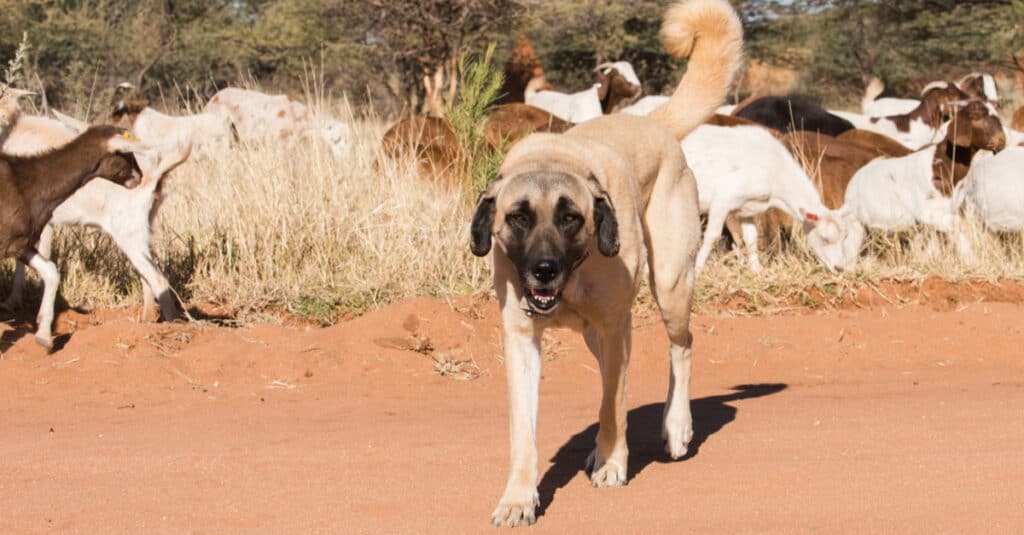
©Bobby Bradley/Shutterstock.com
The name of the Anatolian Shepherd is a misnomer. This massive breed (which weighs up to 150 pounds) isn’t a herding dog at all. Instead, it’s another livestock guardian. Independent, territorial, and protective, the dog will often take up a position on a high vantage point to look out for the entire flock below. It even can work in teams to keep a close eye on larger herds. An ancient breed dating back thousands of years, it is also known as the Kangal Shepherd Dog outside of the United States. Kangal is the small town in the central Turkish region of Sivas from which it originated. They tend to be good dogs for chickens, sheep, and other livestock as well.
#7: Dutch Shepherd
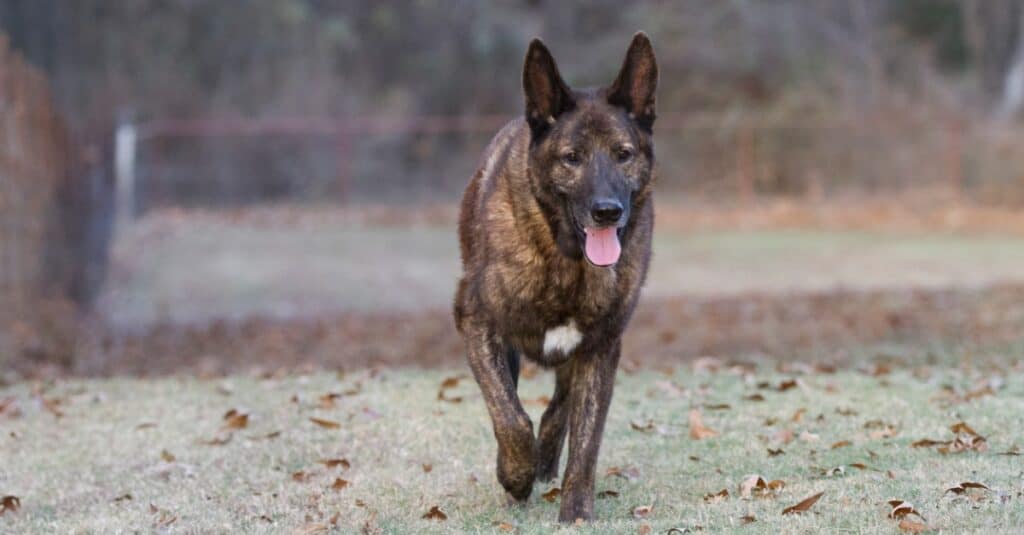
©iStock.com/Tamara Harding
A close relative of the German Shepherd, this breed is extremely smart, loyal, independent, alert, and versatile. It was originally developed over centuries to keep livestock away from roads and crops. It also can pull carts and guard the farm. Weighing between 45 and 75 pounds, the Dutch Shepherd comes in three different variations: short-haired, long-haired, and rough-haired. All of these have a beautiful brindle coat with golden or silver fur mixed in. These dogs are slightly easier to train than their German Shepherd counterparts. However, they are very active, intelligent dogs who require a lot of exercise and mental stimulation.
#6: Old English Sheepdog

©DesignTop/Shutterstock.com
Featuring a peek-a-boo haircut and a long shaggy coat of contrasting dark and white patterns, the Old English Sheepdog is a strong, muscular breed that weighs up to 100 pounds. Smart, loyal, and gentle, it was originally bred in the late 18th century from a combination of various European dogs for herding and moving livestock between the ranch and the town. The herding behavior is so ingrained in its temperament that the dog may even try to herd people and other animals, which can be gently dissuaded with proper training. They also greatly enjoy the companionship of people though you should watch them around children. These dogs feel it is their job to keep livestock in line and quiet. They may want to do the same with running, screaming children. You may just fall in love with its confident, charming personality.
These dogs do require very extensive grooming and do best with a full-body shave at least twice a year.
#5: German Shepherd
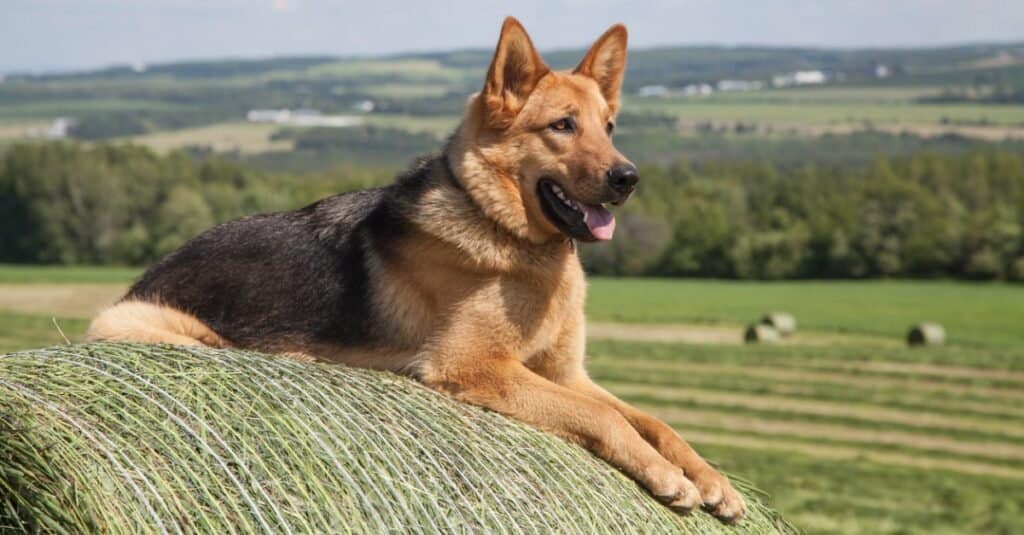
©iStock.com/Lurin
The German Shepherd, which originated in the late 19th century, is one of the most intelligent and versatile dogs in the world. While today it is primarily used for police work, patrolling, and search and rescue, it still excels at its original task of herding and guarding livestock. Loyal, brave, and confident to the end, the German Shepherd is perhaps the ultimate multi-purpose dog. It is characterized by an athletic, muscular body (weighing up to 90 pounds) and noble bearing. Black and tan is the most common color combination, but it also comes in blue, sable, white, and more.
The American Kennel Club claims this dog is the second most popular breed in the country. Provided it receives enough mental and physical stimulation, it makes a great companion for families of all kinds.
#4: Australian Cattle Dog
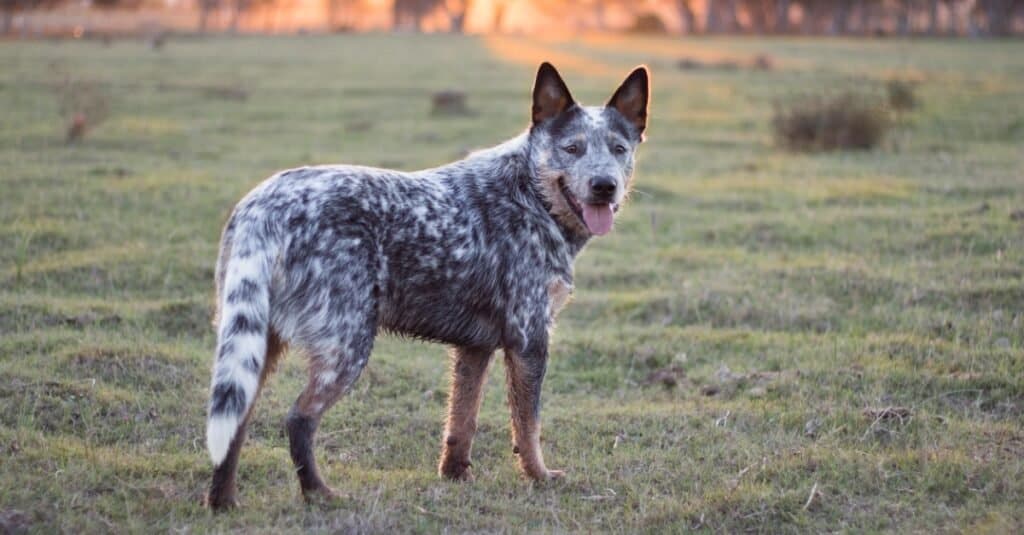
©iStock.com/Madelein_Wolf
Also known as the Blue Heeler or Queensland Heeler for its tendency to nip at the heels of livestock, the Australian Cattle Dog arose from a cross between wild dingoes and drover dogs in the 19th century. The result was a sturdy muscular herder with enormous reserves of strength and energy as well as a fine gait. These dogs are loyal, intelligent, and eager to please their owner. While they do have immense talents for hunting and the protection of livestock, this breed excels most of all at moving and driving cattle around the ranch. The dogs are born with white fur that eventually matures into a blue-gray or red coat with a mottled pattern. They normally weigh between 35 and 50 pounds.
Like most herding dogs, these highly intelligent athletes do best with lots of exercise and a job to do.
#3: Pembroke Welsh Corgi
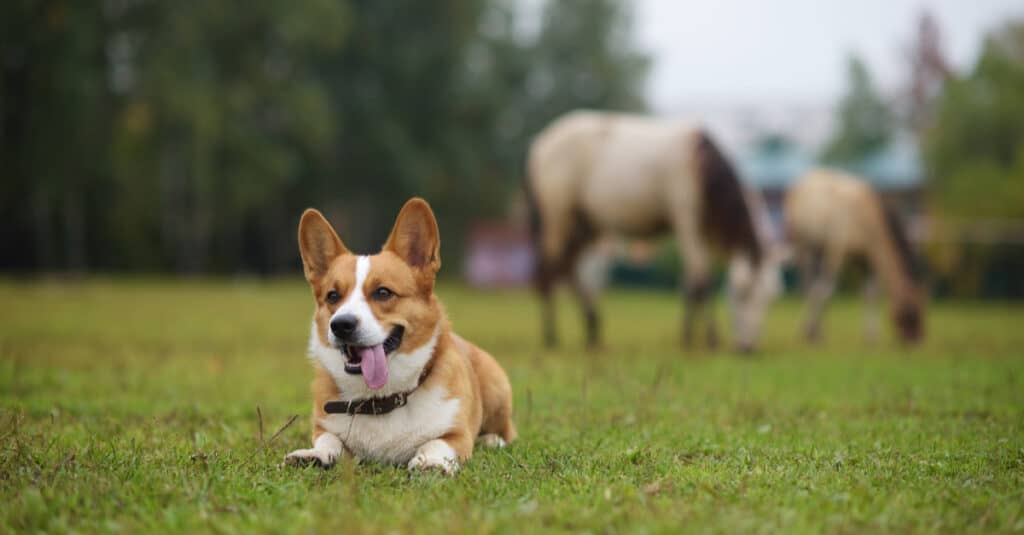
©Dmitriy Kostylev/Shutterstock.com
Originating from the county of Pembrokeshire in Wales, the Corgi inherits a dwarfism trait that gives it a low-slung body and short legs. Despite its small size, the Welsh Corgi is a strong, athletic, muscular dog that drives the livestock by nipping at the heels. Fearless and vigilant, they are great dogs for protection and guard duty as well. Many people around the world (including Queen Elizabeth II) enjoy these intelligent, friendly, and whimsical dogs purely for their companionship. The thick medium-length double coat comes in fawn, red, sable, and black and tan colors with or without white markings.
You can read more about the Pembroke Welsh Corgi here.
#2: Australian Shepherd
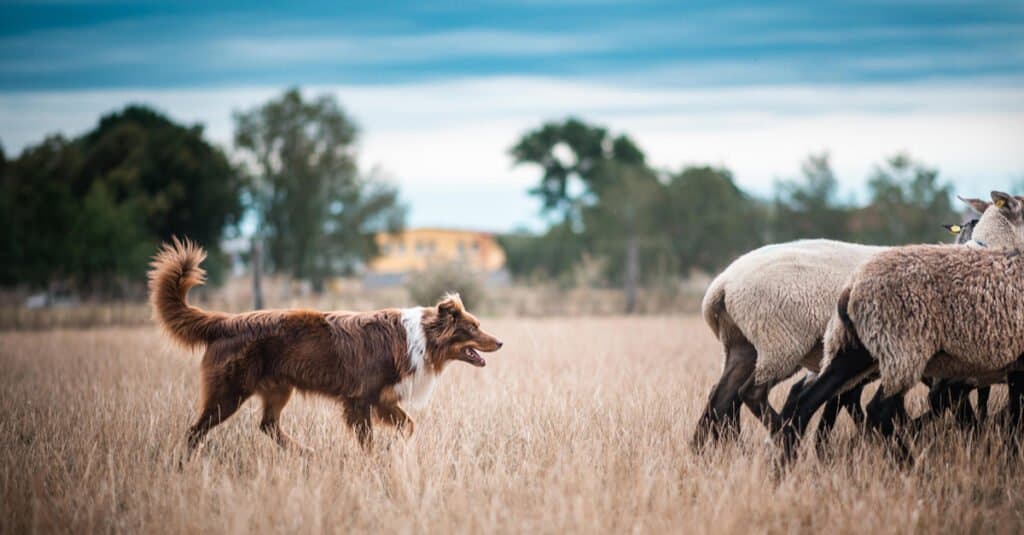
©Ellis Berankova/Shutterstock.com
The Australian Shepherd is not only one of the most talented ranch dogs for herding, but it’s also one of the most popular breeds in the United States. Created from strong European ancestry and then perfected in California, this breed is enormously intelligent, outgoing, and work-oriented with its bountiful reserves of energy. Weighing up to 65 pounds, the Australian Shepherd is characterized by a long double coat of blue or red merle or solid black or red with some markings. They make great companions around the home as well as long as you can provide enough exercise and stimulation.
#1: Border Collie

©iStock.com/Vladimir1965
Developed over centuries near the Scottish border from a combination of Roman herding dogs and Viking stock, the Border Collie is a medium-sized breed weighing anywhere between 30 and 55 pounds. The combination of athleticism, loyalty, obedience, and immense working intelligence makes it one of the most popular types of farm dogs in the world. It is characterized by a long rough or smooth double coat (depending on your preference) with a huge variety of different colors, including black, blue merle, lilac, gold, brindle, and more. These highly affectionate, quirky, and playful dogs — often confused with Australian Shepherds — have a tremendous work ethic and drive. Border collies may not be the best choice for a family pet as they may attempt to herd children, cats, or other animals.
These dogs are almost a necessity on many farms and they are not happy unless they have a job to do. If you do not provide that job, they will invent one for themselves. This may be something like chasing cars, obsessing over frisbee, herding children, or anything else the active imagination of a border collie can envision. Border collies also excel at active sports such as agility, flyball, or frisbee.
Keep in mind that in some countries, there is no distinction between different types of collies, whereas in other countries each one may be a different breed entirely.
You can read more about the Border Collie here.
Our research shows that 10 types of farm dogs (ranch dogs) are as follows:
| Breed | |
|---|---|
| 1. | Border Collie |
| 2. | Australian Sheherd |
| 3. | Pembroke Welsh Corgi |
| 4. | Australian Cattle Dog |
| 5. | German Shepherd |
| 6. | Old English Sheepdog |
| 7. | Dutch Shepherd |
| 8. | Great Pyrenees |
| 9. | Great Pyrenees |
| 10. | Jack Russell Terrier |
Up Next…
- Collie vs Border Collie: What Are 8 Key Differences? Do you know what the differences are between the various collies? Check out this article to learn more.
- The 10 Best Farm Animals Have you ever thought of have a small farm? Check out some of the more common farm animals here.
- Maremma Sheepdog Vs Great Pyrenees: Top Key Differences These livestock guardian dogs are essential workers on many farms. Learn more about them and what they do.
The photo featured at the top of this post is © iStock.com/Vladimir1965
Ready to discover the top 10 cutest dog breeds in the entire world?
How about the fastest dogs, the largest dogs and those that are -- quite frankly -- just the kindest dogs on the planet? Each day, AZ Animals sends out lists just like this to our thousands of email subscribers. And the best part? It's FREE. Join today by entering your email below.
Thank you for reading! Have some feedback for us? Contact the AZ Animals editorial team.





